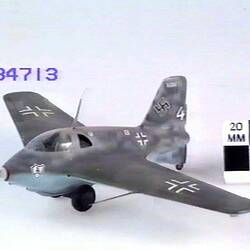Summary
Scale model, 1:36, of a Messerschmitt Bf 109E, built by R.D. Ramsay under contract to Museum Victoria. It was completed and delivered in 1954.
The Messerschmitt Bf 109 was the most significant fighter aircraft operated by the German Luftwaffe between 1937 and 1945. It was obsolete by 1942 but continued to be built even after 1945 in Czech and Spanish production. About 35,000 Bf 109's of all models were manufactured, the largest production run of any fighter aircraft. The prototype was first flown in May 1935 using a Rolls-Royce Kestrel engine which had been borrowed without permission from Rolls-Royce which had sent the engine to Germany to be fitted to a Heinkel He 70 aircraft it had ordered. It was designed by Professor Willy Messerchmitt and Walter Rethel (who had previously worked for Fokker) along similar lines to the company's earlier Bf 108 civilian touring aircraft, one of which was brought to Australia by Guinea Airways in 1937. Early prototypes, Bf 109B & C models with Junkers Jumo 210 engines entered service with the Luftwaffe in 1937 and were used in combat by the Geman Condor Legion during the Spanish Civil War.
The Bf 109E was the first mass-produced and fully developed combat model with a more powerful Daimler-Benz DB601A inverted V12 engine featuring fuel injection. A small number were sent to Spain before the end of the conflict in 1939. By September 1939 when World War II began, the Bf 109E equipped the majority of Germany's day fighter units and was used in support of the invasion of Poland as well as the conquest of Western Europe in 1940. It was only during the Battle of Britain later in 1940 that RAF pilots flying Spitfire and Hurricane fighters provided effective opposition and the short range of the Bf109E exposed the German bomber force to RAF attacks. The narrow undercarriage which was attached to the fuselage rather than the wings was the cause of many landing accidents. From 1941, the Bf 109F began to replace the E model in front-line service but it continued to be used in North Africa, on the Eastern front and by a number of nations which had ordered export versions including Switzerland. One Bf 109E shot down over England was brought to Australia during the war and was exhibited in various locations including the Melbourne Town Hall to raise money for war bonds. It was later scrapped at Laverton in Victoria. A later Bf 109G-6 was also brought to Australia in 1946 as a war prize and is now held in the collection of the Australian War Memorial in Canberra.
More Information
-
Collecting Areas
-
Acquisition Information
Purchase
-
Modelmaker
Mr R. D. Ramsay, Melbourne, Greater Melbourne, Victoria, Australia, 1954
-
Date Depicted
-
Brand Names
-
Classification
Air transport, Aircraft, Model propeller aircraft - military
-
Category
-
Discipline
-
Type of item
-
Overall Dimensions
305 mm (Width), 277 mm (Depth), 120 mm (Height)
Measurements of model only. 'Width' is model wingspan, 'Depth' is model length from nose to tail, 'Height' is overall model height while resting on its undercarriage.
-
Other Dimensions
305 mm (Width), 277 mm (Depth), 123 mm (Height)
Overall measurements of model including its base. 'Width' is model wingspan, 'Depth' is model length from model nose to tail end of base, 'Height' is overall model height including base.
-
Model Scale
1:32
-
Keywords
Aeroplanes, Fighters, Military Aircraft, Model Aeroplanes, Scale Models, Wars & Conflicts, World War II, 1939-1945


